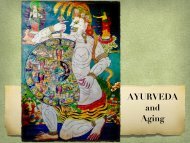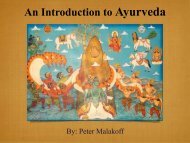How Thoreau's Walden Pond Mixed with the Ganges and Yoga Came to America with Swami Vivekananda
One early morning in 1846, during the coldest days of a New England winter, Henry David Thoreau looked out the window of his small cabin on Walden Pond and saw men cutting its ice into blocks. That ice was hauled by horse to a railroad that ran across the western edge of Walden Pond, packed into a boxcar, taken to Boston and loaded onto a clipper ship that sailed to Calcutta, India, arriving about four months later. Once there, that ice was purchased by grateful members of the East India Company. Thoreau had witnessed a small part of the global ice trade between New England and India that took place during the latter part of the nineteenth century. When Thoreau considered the ice trade, his vision sailed on metaphors far beyond the scope of business. The waters he imagined flowed both east and west and carried not just natural elements, but culture, religion and philosophy as well. He envisioned that after arriving in Calcutta, the New England ice of Walden Pond would eventually melt and run downhill where it would join with the sacred water of the Ganges. He wrote in Walden: "It appears that the sweltering inhabitants of Charleston and New Orleans, of Madras and Bombay and , drink at my well. In the morning I bathe my intellect in the stupendous and cosmogonal philosophy of the , since whose composition years of the gods have elapsed, and in comparison with which our modern world and its literature seem puny and trivial; and I doubt if that philosophy is not to be referred to a previous state of existence, so remote is its sublimity from our conceptions. I lay down the book [Bhagavad-Gita] and go to my well for water, and lo! there I meet the servant of the Bramin, priest of and and who still sits in his temple on the Ganges reading the , or dwells at the root of a tree with his crust and water jug. I meet his servant come to draw water for his master, and our buckets as it were grate together in the same well. The pure Walden water is mingled with the sacred water of the Ganges." This book tells the story of these waters . . .
One early morning in 1846, during the coldest days of a New England winter, Henry David Thoreau looked out the window of his small cabin on Walden Pond and saw men cutting its ice into blocks. That ice was hauled by horse to a railroad that ran across the western edge of Walden Pond, packed into a boxcar, taken to Boston and loaded onto a clipper ship that sailed to Calcutta, India, arriving about four months later. Once there, that ice was purchased by grateful members of the East India Company. Thoreau had witnessed a small part of the global ice trade between New England and India that took place during the latter part of the nineteenth century.
When Thoreau considered the ice trade, his vision sailed on metaphors far beyond the scope of business. The waters he imagined flowed both east and west and carried not just natural elements, but culture, religion and philosophy as well. He envisioned that after arriving in Calcutta, the New England ice of Walden Pond would eventually melt and run downhill where it would join with the sacred water of the Ganges. He wrote in Walden: "It appears that the sweltering inhabitants of Charleston and New Orleans, of Madras and Bombay and , drink at my well. In the morning I bathe my intellect in the stupendous and cosmogonal philosophy of the , since whose composition years of the gods have elapsed, and in comparison with which our modern world and its literature seem puny and trivial; and I doubt if that philosophy is not to be referred to a previous state of existence, so remote is its sublimity from our conceptions.
I lay down the book [Bhagavad-Gita] and go to my well for water, and lo! there I meet the servant of the Bramin, priest of and and who still sits in his temple on the Ganges reading the , or dwells at the root of a tree with his crust and water jug. I meet his servant come to draw water for his master, and our buckets as it were grate together in the same well. The pure Walden water is mingled with the sacred water of the Ganges."
This book tells the story of these waters . . .
Create successful ePaper yourself
Turn your PDF publications into a flip-book with our unique Google optimized e-Paper software.
Vaishnaiva Bhakti<br />
“Gaudiya Vaishnavism (also known as<br />
Chaitanya Vaishnavism <strong>and</strong> Hare<br />
Krishna) is a Vaishnava religious movement<br />
founded by Chaitanya Mahaprabhu<br />
(1486–1534) in India in <strong>the</strong> 16th<br />
century. "Gaudiya" refers <strong>to</strong> <strong>the</strong> Gauḍa<br />
region (present day Bengal/Bangladesh)<br />
<strong>with</strong> Vaishnavism meaning "<strong>the</strong> worship<br />
of Vishnu.” Its philosophical basis is primarily<br />
that of <strong>the</strong> Bhagavad Gita <strong>and</strong> Bhagavata Purana, as well as o<strong>the</strong>r Puranic<br />
scriptures <strong>and</strong> Upanishads such as <strong>the</strong> Isha Upanishad, Gopala Tapani<br />
Upanishad, <strong>and</strong> Kali Santarana Upanishad.<br />
The focus of Gaudiya Vaishnavism is <strong>the</strong> devotional worship (bhakti) of<br />
Radha <strong>and</strong> Krishna, <strong>and</strong> <strong>the</strong>ir many divine incarnations as <strong>the</strong> supreme forms<br />
of God, Svayam Bhagavan. Most popularly, this worship takes <strong>the</strong> form of singing<br />
Radha <strong>and</strong> Krishna's holy names, such as "Hare,” "Krishna" <strong>and</strong> "Rama,”<br />
most commonly in <strong>the</strong> form of <strong>the</strong> Hare Krishna (mantra), also known as kirtan.<br />
The movement is sometimes referred <strong>to</strong> as <strong>the</strong> Brahma-Madhva-Gaudiya sampradaya,<br />
referring <strong>to</strong> its traditional origins in <strong>the</strong> succession of spiritual masters<br />
(gurus) believed <strong>to</strong> originate from Brahma. It classifies itself as a mono<strong>the</strong>istic tradition,<br />
seeing <strong>the</strong> many forms of Vishnu as expansions or incarnations of <strong>the</strong><br />
one Supreme God, adipurusha . . .<br />
Release from <strong>the</strong> process of samsara (known as moksha) is believed <strong>to</strong> be<br />
achievable through a variety of yoga processes. <strong>How</strong>ever, <strong>with</strong>in Gaudiya<br />
Vaishnavism it is bhakti in its purest state (or "pure love of God") which is given<br />
as <strong>the</strong> ultimate aim, ra<strong>the</strong>r than liberation from <strong>the</strong> cycle of rebirth.<br />
Gaudiya Vaishnavas believe that God has many forms <strong>and</strong> names, but that<br />
<strong>the</strong> name "Krishna" is <strong>the</strong> 'fullest' description because it means "He who is allattractive,”<br />
covering all of God's aspects, such as being all-powerful, supremely<br />
merciful <strong>and</strong> all-loving. God is worshiped as <strong>the</strong> eternal, all-knowing, omnipresent,<br />
all-powerful <strong>and</strong> all-attractive Supreme Person. Names of God from o<strong>the</strong>r<br />
religious traditions, such as Allah <strong>and</strong> Jehovah, are also accepted as bonafide titles<br />
of <strong>the</strong> same Supreme Person.”<br />
One of <strong>the</strong> defining aspects of Gaudiya Vaishnavism is that Krishna is worshiped<br />
specifically as <strong>the</strong> source of all Avataric incarnations of God. This is<br />
based on quotations from <strong>the</strong> Bhagavata Purana, such as "krsnas tu bhagavan<br />
svayam,” translated as "Krishna is <strong>the</strong> original Personality of Godhead" <strong>and</strong><br />
from <strong>the</strong> Bhagavad Gita where Arjuna, when speaking <strong>to</strong> Krishna, states:<br />
"You are <strong>the</strong> Supreme Personality of Godhead, <strong>the</strong> ultimate abode, <strong>the</strong> purest,<br />
<strong>the</strong> Absolute Truth. You are <strong>the</strong> eternal, transcendental, original person, <strong>the</strong><br />
unborn, <strong>the</strong> greatest. All <strong>the</strong> great sages such as Narada, Asita, Devala <strong>and</strong> Vyasa<br />
confirm this truth about You, <strong>and</strong> now You Yourself are declaring it <strong>to</strong> me."<br />
Krishna is described elsewhere as <strong>the</strong> "seed-giving fa<strong>the</strong>r of all living beings"<br />
<strong>and</strong> is worshiped <strong>with</strong>in <strong>the</strong> Gaudiya tradition literally, as such - Krishna being<br />
<strong>the</strong> "sustaining energy of <strong>the</strong> universe"<br />
– Wikipedia, The Free Encyclopedia<br />
Related Glossary Terms<br />
Bhaktivedanta <strong>Swami</strong>, Hare Krishna movement, ISKCON, <strong>Swami</strong> B.G. Narasingha<br />
Index<br />
Find Term<br />
Chapter 1 - <strong>How</strong> <strong>Thoreau's</strong> <strong>Walden</strong> <strong>Pond</strong> <strong>Mixed</strong> <strong>with</strong> <strong>the</strong> <strong>Ganges</strong> <strong>and</strong> <strong>Yoga</strong> <strong>Came</strong> <strong>to</strong> <strong>America</strong> <strong>with</strong> <strong>Swami</strong> Vivekan<strong>and</strong>a


















